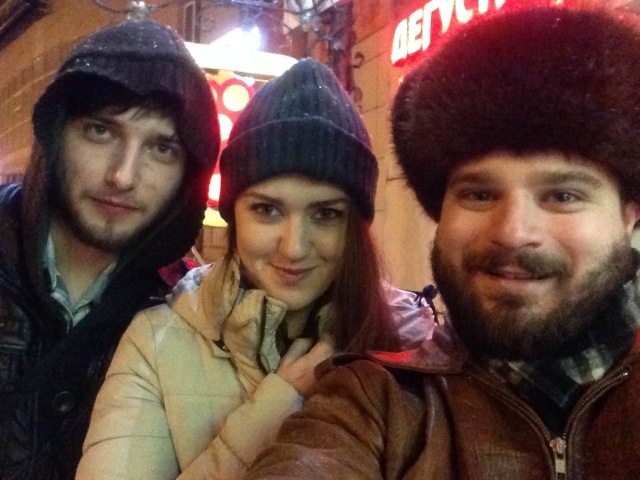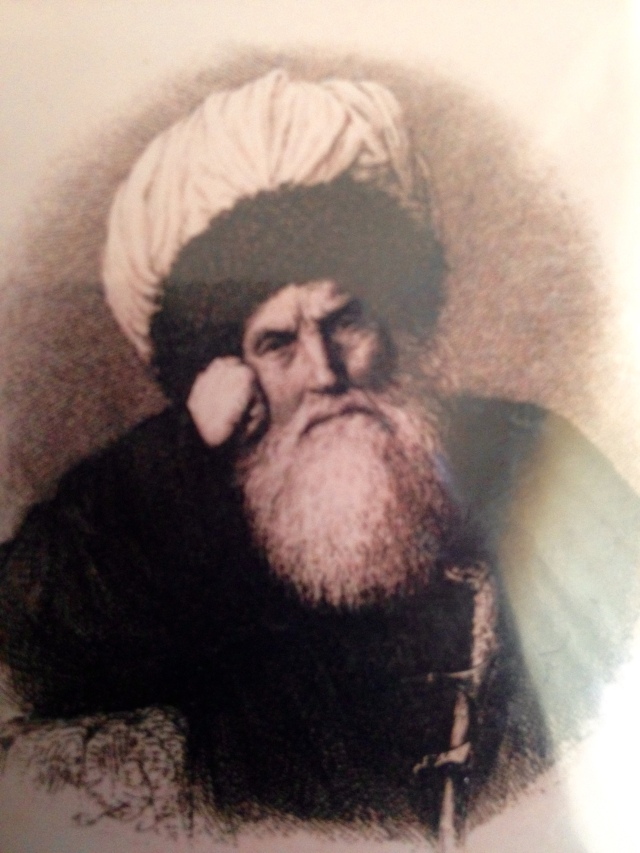Hello friends and neighbors, I hope you are well doing well in your respective corners of the world. January is coming to a close and these pass few days have been filled with fun and adventures. The landscape looks like a winter wonderland. It has been snowing for the last four days and the cold has returned. The whole of the Caucasus has been blanketed in snow, the bitter cold forming ice on everything. From Moscow to Tbilisi, snow fell across the steppe lands and over the mountains. It seems that Russia, Transcaucasia and the Eastern United States are sharing the same fate together. It has been 14 degrees (-10 for those of you who read Celsius) here for the last two days, but here at this elevation, the cold doesn’t seem to cut through you like it does in Nebraska. Patterns of frost grow on the windows and spread like fingers across the glass in the mornings. It was so cold yesterday morning that I when I opened the kitchen window to get some fresh air, my plate that was heating up on the stove cracked right down the middle as soon as the cold air touched the it’s hot surface. I was stunned.
Classes had been going as smoothly was possible. Our schedule has been changed yet again, so it has been difficult to establish a routine. We now have a full day of classes on Thursday starting at 08:30 and it is going to be a nightmare. Two classes of Russian grammar, back to back. I think my brain is going to turn into a trick, grey soup at the end of the third course of Russian reading. Forget about Russian etiquette at the end of the end, I don’t think I’ll have the concentration for it. It will be a battle, that is for sure. I still have had no word about classes in Georgian. I was hoping to receive word about it on Monday but, alas nothing. I will make inquiries about in tomorrow. On Tuesday I have day of rest and relaxation, which is nice (we’ll see how long it lasts). It is a nice break at the beginning of the week, a calm moment before going head first into the busy days of Wednesday and Thursday. At least we’ll earn our tradition of “beer Thursdays” by working all day long and ending it with 3 or 4 liters of beer. It sounds like a norm weekend in the States. It makes total sense. Work yourself to death on the weekdays and recover by drinking yourself to death during the weekend. There’s got to be a better way to do that.
Speaking to “beer Thursdays,” our last get together was excellent and very enjoyable. Diogo, Emma, Jeanne, Sara, and I walked to Pizza Neopolitano to have sushi and beer. Yes, I know that gooding to “pizza place” for sushi sounds strange, but you haven’t had the “Banzai,” “Tokyo,” and “Shanghai” rolls that they have here. They are great tempura rolls with salmon, tuna and different sauces, the “Shanghai” roll having a spicy after taste that is very nice. It sounded very strange ordering them as I was naming off two cities and the Japanese phrase (banzai) for “long live the Emperor” and/or “attack/change” depending on the context. “Yeah, I’d like to have the ‘Long live the Emperor,’ ‘Tokyo and ‘Shanghai’ please…” We all got a crack out of that one. When ordering I almost couldn’t keep it together, laughing as soon as our waitress was out of ear shot. I also ordered one of my favorite stouts here, a glass of Bochkarev (I also love Žatecký Gus and Kozel, two beers that are Czech style and we started the evening chatting about classes, life in our respective countries and so on. Vika then later joined us which was a treat within itself and we all talked some more, the girls getting liquored up on mojito’s and Diogo, Vika and I having more beer. As the night progressed, the girls started to get tried and headed home, leaving Diogo, Vika and I to ourselves. We talked some more, most of the conversation concerning exchange programs and studying overseas, as well as Vika’s thesis work for the end of her senior. It then hit around 22:30 and I Vika, had to call it quiets, so we said good night and Diogo and I sat together talking about our experiences in Russia and around the world. It is also a joy to speak with them all and love our Thursday night outings.
The highlight of these past few weeks had to be our trip to Nalchik that we took last Saturday. I have been to Nalchik many times, either going with Elberd to see his family and hangout, or on my own, just to absorb Kabardian culture at it’s finest. Whether seeing the Cultural Museum in Nalchik or eating haliva (a pastry filled with either cheese, pears or potatoes, Helive ch’ert’ofre q’eyre delhu in Kabardian) or mataz (a Kabardian dumpling, similar to manti that I like so much), I always joy my visits to this city. Diogo, Jeanne, Sara and Anna came with me. It was funny, it that originally, Emma was going to come with us as well as, but with the time came, she baled. The irony of this was that Emma had the week before told me after coming back from Moscow, she was bored and wanted a change of scenery. The morshot (bus) ride is not very long, only an hour, but this trip to Nalchik seemed to take forever, as it was snowing heavily and the driver could only go so fast on the roads. Anna and I were very excited for this trip because of our mutual love of Circassian things and had always wanted to visit Nalchik together. I had brought my Circassian flag and cherkess papakha with me for the trip, and has we entered one of the main squares (the Square of the 400th Union Anniversary, recognizing the marriage between the princess and Tsar Ivan IV, unifying the ancient Kingdom of Kabarda with the Russian Empire), we took a picture of us with the flag, with the statue of Princess Maria Temryukovna. We took several photos, changing hats, as I as wearing my Russia ushanka for the cold weather.

We then shopped by one of the most praise stores in Nalchik that specializes in Circassian regalia and cultural items. This is the same store where I buy my Adige key chains and my Adige flag and t-shirt. The owners of the store recognized me when I entered and we chatted for a little bit. It is so nice to be recognized when you enter a shop like this. In Pyatigorsk, there is a little shop that sells Russian cultural items such as khokhloma and matryoshkey. I brought my sun glasses case here. I was so surprised when the shop owner recognized me after two years. In Nalchik, I was on a mission to get myself a nice, traditional cherkesska. The cherkesska (or chokha in Georgian or Shwakh-Tsia in Adyghe) is the traditional dance of many of the various Caucasian nations. The word cherkesska is a Russian word, and literally means, “Circassian dance.” In the original Adyghe, the word is “Shwakh-Tsia” meaning “the cloth that fits you.” In general both the Circassian Shwakh-Tsia and the Georgian chokha share similarities, but in most cases they have different decorations for the spaces on the cartridge pouches called masrebi (the Georgian word) or gaziri (the Russian word). These pouches were first used as places to put sticks of dried meat or ligar for travelers and warriors to munch on during long rides from aul to aul (fortified towns in the mountains). These pouches would also store millet of wheat, rye or corn to make pasta (a Caucasian variety of polenta). When firearms were introducing into the Caucasus from Ottoman and Russian traders, these pouches become places for the rifle and pistol cartridges.
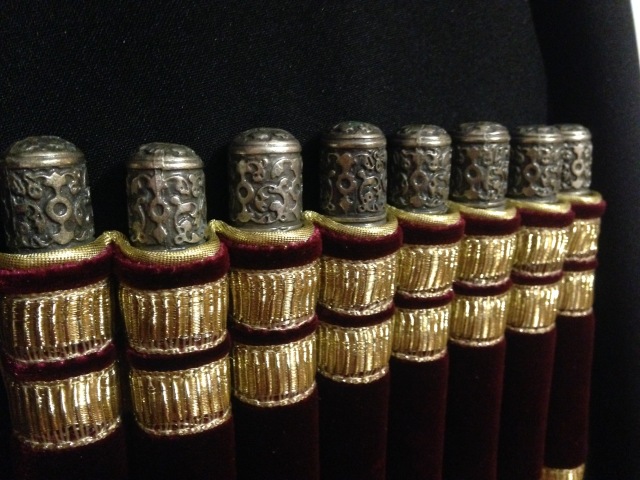
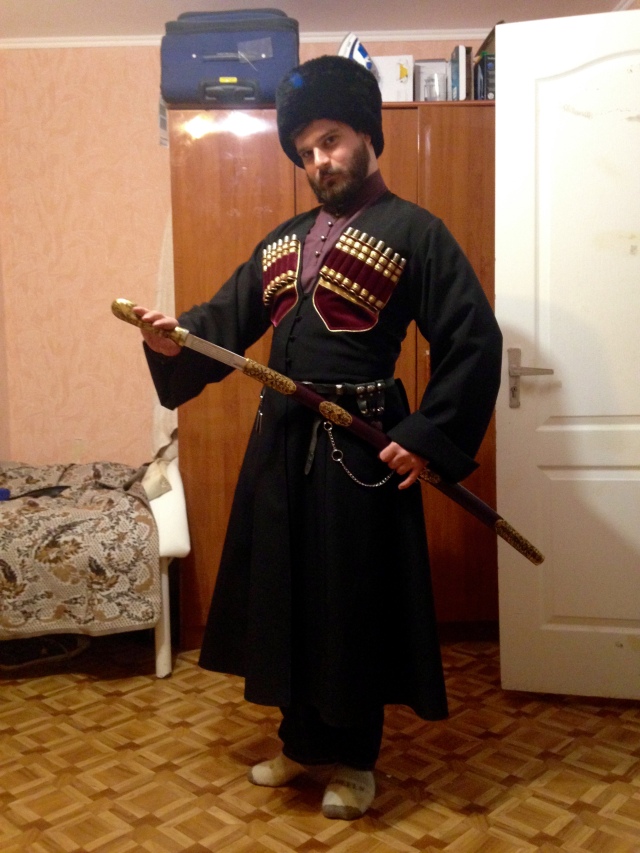
The cherkesska in the North Caucasus is mostly made of black, grey, white, blue, red, green and brown fabric, with some ethnic groups having specific colors noting social status or factions. In Georgia, the black cherkesska/chokha was reserved to members of the “Order of Chokhsani” who represented the elite society of citizens, whereas in Kabardian culture, the black was for the lower classes (Kabardian society was unique in the North Caucasus as it was federal), red for nobles and white being reserved to higher nobles and princes. Some Caucasian cultures also defined a persons age by the color of fabric. Most cherkesska will have black leather belts, decorated with silver pieces, holding a kindjal or (short knife in Adyghe). Underneath the cherkesska is an undershirt called a beshmat (in Adyghe) or akhaluki (in Georgian) which is buttoned from the neck to about the middle chest and is usually a complimenting color. The belt, beshmet and cherkesska were altogether $180, which I was very surprised by. I inquired about the cost and tried on the cherkesska and beshmet I wanted. A black cherkesska with red pouches and golden trimming; the beshmet being a shade of purple or an off maroon (Taylor would know better being an artist). Both fit me very well, putting “the fabric that fits you” to it’s literally meaning. I didn’t have enough rubs on me at that moment, so I asked with Anna’s help to put it on reserve, as I would return with the cash later. We then went to the bank and I managed to get the money I needed. I later at the end of the trip got my cherkesska, beshmet and belt (I didn’t get the boots, as they need to be custom ordered and fitted, being $150 for a pair).
We took several photos of me wearing the cherkesska and my friends were (at least according to Diogo) were happy to see me so excited to be finally for-filling a dream. Ploshchad Lenina was not that far away, so we walked to see the Belye Dom (or White House, a kind of presidential palace) and the monuments to the Second World War. In the square that are several monuments that pay tribute to the Kabardian and Balkarian veterans and their efforts fighting against the Nazis during the occupation of the Caucasus. I then started to explain some of the history behind the people of this Autonomous Republic. I was in the middle of explaining the geography of the region and the deportation of some of the local ethnic groups by the Russian Empire during the middle of the 19th century, emphasizing that the Kabardians siding with the Russians, preventing their deportation, when I noticed Anna was recording me in “teacher mode.” It was good to finally unlash my love of this regions history and people by sharing it with others (something that regrettable, people at college never really asked me about). We then took some more photos with the Adige flag. After that we begun walking toward the statue of Lenin, when all of a sudden someone start throwing snowballs. It then turned into a full blown snowball fight. It was a lot of fun and made of a wonderful moment. Anna then showed us a tradition Caucasian restaurant that had a few Kabardian food items on the menu, including ligar with pasta. We had a huge order of manti with lakum (Kabardian bread, one of my favorites). We talked for a while, enjoying each others company. We then went to the Kabardian Museum of Culture and History. It is always fun to return to this place and relearn and experience the history of the Kabardian people and their Republic. We returned that evening, through a sea of snow.
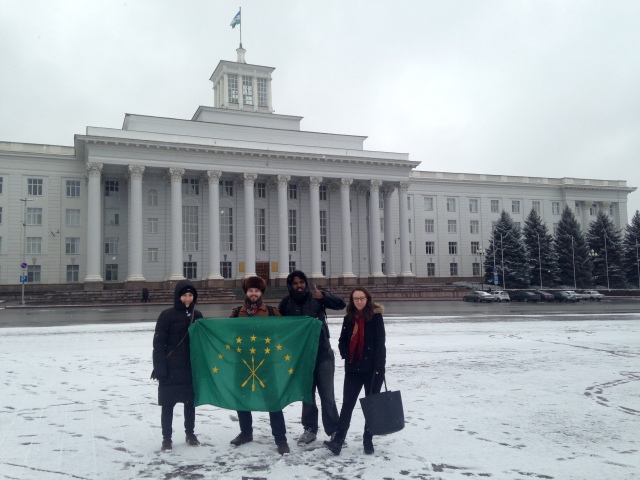
On Saturday, I took a walk in the snow with Alina and Saidat (a friend of Alina’s who is a Chechen). It was good to talk to and see Saidat again. She is very shy, but well spoken when she does talk. We also had a snowball fight on our way up the Mount Malshuk, some of Alina’s Russian and Armenian friends who accompanied us, throwing snowballs at Saidat. I came to her aid, saying in Russian that it was an Americans duty to come to the aid of the people’s fighting for freedom (referencing the Chechen’s struggle for independence from the Russian’s for the last 150 years. Saidat laughed and talked me for my help. The snow continued to fall throughout the day and it was so cold that snow was sticking to my beard and my ushanka. I looked like a yeti. Even the barbed wire surrounding the communications complex onto of Malshuk was covered in snow. The whole place looked like someone bombed it with liquid nitrogen. It was good to speak with Alina and Saidat and I look forward to learning more about Chechen culture through her. We had a culturally connection when I commented that one of the Russian boys had hugged her from behind when we were walking on the mountain. In Chechen culture, men are forbidden to touch unmarried Chechen women. Saidat appreciated that I recognized that she felt uncomfortable and understood the norms within her culture.
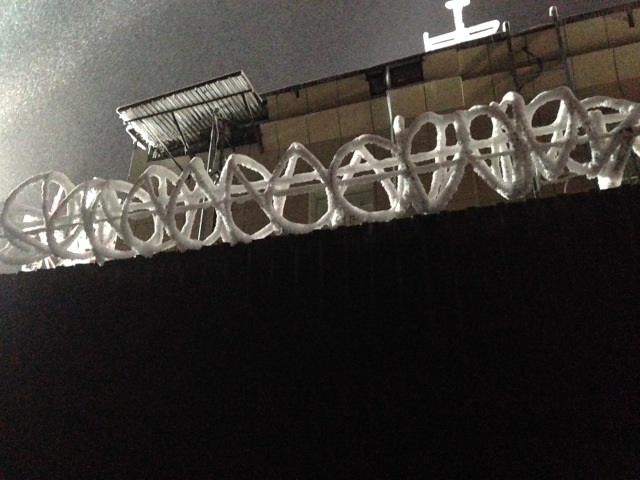
The last part of the week was very interesting. On the 26th of January I was invited to speak with a radio host by the Alina Tkachenko on 104.2 HET in the city of Essentuki (a small town on the other side of Mount Beshtau, about a 30 min train ride). I was asked my faculty to speak on behalf of our faculty. The 26th is Students Day in Russia, highlighting the work that students do and the importance that the hold for the nation. It was a very good experience and honor. We chatted about life in the States, about university standards in both the States and in Russia, about which country had the most beautiful women etc. It was so cool to talk in the radio show, it reminded me of times when I hosted my radio show at Hastings, “House of Trance” for 90.1 KFKX. Alina was very happy to hear that we were fellow colleagues. It was also cool that people were asking me questions through VK (Russian’s Facebook) and that I could answer them. Such a wonderful time and I got great practice for two hours in Russian. I also got to visit the city of Essentuki, something that I had been wanting to do.
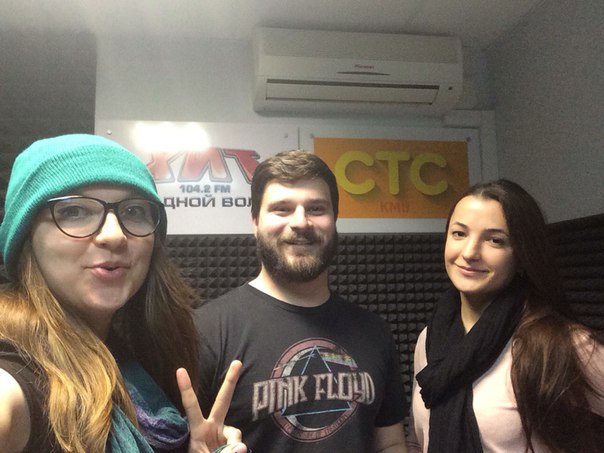
Well my friends, that is it for this blog. Best wishes to you all, from Russia with regards.





